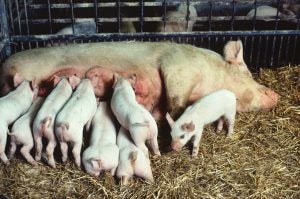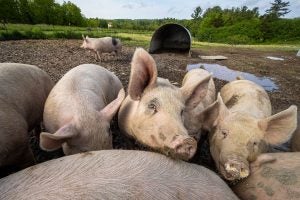Americans consume nearly 318 million pounds of ham during the holiday season. Roughly 130 million hogs are processed each year in the United States to bring products like hams, bacon, ribs, pork chops, and many more to your local grocery.
The top hog producing states are Iowa, Minnesota, North Carolina, Illinois, and Indiana, housing nearly 49 million hogs between them. Pork is one of the main sources of meat in the United States, with each American consuming on average of more 50 pounds of it each year.
Here’s how such an important staple is grown and processed:
Breeding and farrowing
Of course we have to first begin by breeding female hogs, called sows, in order to produce the litters that will be grown and eventually harvested. A pig’s gestation lasts almost exactly three months, three weeks, and three days, with each sow producing an average of 10 or more piglets. A gilt, or a female hog that hasn’t given birth, can be bred as early as 32 weeks old, but not all females go on to be bred — only the best are selected to produce future feeder pigs.
Most commercial swine are bred through the use of artificial insemination (AI), although some producers still use boars (the term for males) for mating. AI helps vary genetics as semen can be shipped from across the world, and it makes it somewhat easier on a farmer to plan and implement breeding strategies.
One unique thing about swine is their cervix, a part of the reproductive tract, has protruding nodules that form a spiral pattern, and therefore the male, and AI breeding devices, have to have a spiral shape in order to breed the female!

When a pig gives birth, we call it farrowing. Sows nurse their piglets for an average of three weeks before they are weaned. During that time, sows are typically confined to a farrowing crate, which helps prevent injury to the piglets and allows the mother sow to have complete access to food, water, and a climate suitable to her liking. Since adults pigs like it much cooler than piglets can stand, farrowing crates are equipped with heat lamps or plates for piglets to warm up on.
You will often find much of the litter piled on top of each other, cuddling on the warming plates, especially after a good meal. After piglets are weaned they move on to the next phase of the operation.
Feeder pigs
Weaned pigs weigh about 10 pounds. These pigs may stay on the breeding farm to reach a feeder pig weight, or they may be transferred to a different farm. Every operation has a different production style — we call these farrow-to-finish, where pigs are born and raised to harvest on the same property, or farrow-to-feeder where piglets are born, weaned, and fed up for a short time before moving on. There are other operation types like feeder-to-finish, where hogs go for the finishing stage before harvest, and some others where hogs may move from farm to farm at each stage of the production cycle.

Feeder pigs are fed a ration of varying protein content until they reach about 40 pounds. If the pigs are on a finishing operation, they will move to another housing unit to be fed further, or they may move to a finish operation on an entirely different farm.
Finishing stage
Finishing a hog is the timeframe when a hog leaves the feeder stage at 40 pounds and is fed until reaching finishing weight, typically around 280 pounds.
Pigs are fed a diet of corn, soy, and vitamins and minerals. Some operations may include other feed ingredients based on their area and what is locally available to them. Once a hog reaches harvest weight they are sent on to the final stage of production.
Harvesting and processing
At nearly 280 pounds the hog is a perfect blend of muscle and fat, rendering the desired cuts without much waste. Hogs have very fine hair all over their body, so this must first be singed off, typically with a very hot water bath. Once the hide is clean, the carcass is split into two while hanging on the rail. This makes maneuvering much easier and also helps fit more products into the hanging room. A hog carcass may hang for only 24 to 48 hours before it is cut into sub-primals and even further into market cuts like hams, bacon, picnic shoulders, and more.
If you are interested in seeing the entire harvesting and processing process, check out this video from the American Meat Institute’s Glass Walls Project:
After harvest, the cuts will be shipped to be further processed. Pork is typically smoked, cured, or some other type of processing before purchased by the consumer. Many holiday hams will be roasted, with the addition of some type of glaze to sweeten the product.
Pork is an important part of the U.S. economy and the American diet. There is a lot of research, science, care and technology that go into producing the perfect portion of pork for you and your family.
Since pork production is so heavily concentrated to a few states, the practices may not be widely seen by the American public. It’s important to be transparent about how our food gets from farm to table, so be sure to share this small snippet of information, hopefully over breakfast with bacon!
Michelle Miller, the “Farm Babe,” is an internationally recognized keynote speaker, writer, and social media influencer and travels full time to advocate for agriculture. She comes from an Iowa-based row crop and livestock farming background and now resides on a timber farm in North Central Florida.



